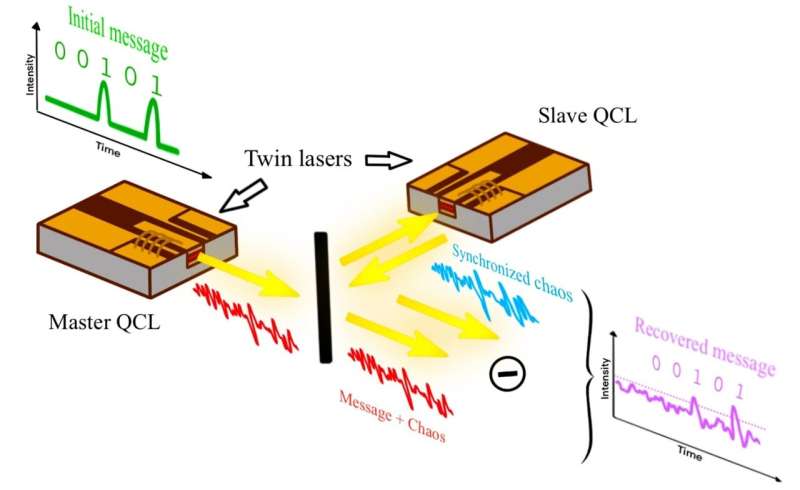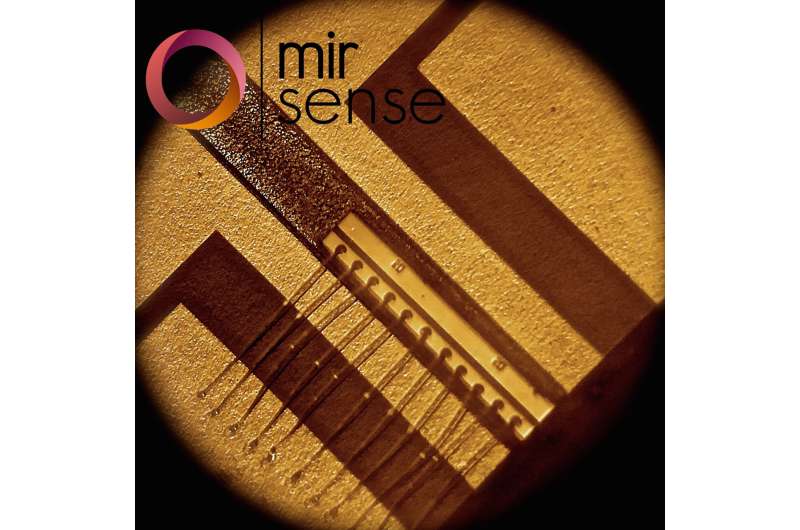June 22, 2021 feature
Researchers propose the use of quantum cascade lasers to achieve private free-space communications

Free-space optical communication, the communication between two devices at a distance using light to carry information, is a highly promising system for achieving high-speed communication. This system of communication is known to be immune to electromagnetic interference (EMI), a disturbance generated by external sources that affects electrical circuits and can disrupt radio signals.
While some studies have highlighted the possible advantages of free-space optical communication, this system of communication has so far come with certain limitations. Most notably, it is known to offer limited security against eavesdroppers. Researchers at Télécom Paris (member of Institut Polytechnique de Paris), mirSense, Technische Universität Darmstadt and University of California Los Angeles (UCLA) have recently introduced a unique system for more secure free-space optical communication based on a technology known as quantum cascade laser, a specific type of semiconductor laser that typically emits mid-infrared light.
"The core idea behind our research is that private free-space communication with quantum key distribution (i.e., based on quantum physics properties) is promising, but it is probably years away, or even further," Olivier Spitz, one of the researchers who carried out the study, told TechXplore. "Currently, the main limitations of this technology are the requirements for cryogenic systems, very slow data rates and costly equipment."
In their paper, featured in Nature Communications, Spitz and his colleagues propose an alternative to previously proposed systems for achieving private free-space communication, which implement a cryptographic protocol based on the laws of quantum mechanics. The new system they devised is based on the use of two uni-directionally coupled quantum cascade lasers.
The researchers' approach combines what is known as chaos synchronization with the mid-infrared wavelength of quantum cascade laser technology. Chaos synchronization is a specific property that has been examined in the context of semiconductor lasers for decades.

"Chaos synchronization is the key to private communication, while mid-infrared wavelength means that the attenuation of the atmosphere is low in comparison with near-infrared wavelength, where most of the semiconductor lasers emit," Spitz explained. "We can thus envision transmission with a very long range and with immunity to the atmospheric conditions. Moreover, the mid-infrared wavelength implies stealth, as the background radiation is in the same wavelength domain."
The mid-infrared wavelength of the quantum cascade lasers makes it even harder for a potential eavesdropper to decipher information exchanged using the researchers' system. This means that the security of communications is increased further.
"I feel the most notable achievement is the successful chaos synchronization between two QCLs," Spitz said. "For a long time, the possibility to generate temporal chaos in this type of structure was controversial because they rely on a different technology, in comparison with most of the semiconductor lasers, which overall makes QCLs more stable, so not really prone to chaos. A few years ago, we experimentally demonstrated that QCLs can generate temporal chaos, and we now took this one step further by achieving private communication based on chaos synchronization."
So far, the researchers merely described a proof of concept of their proposed system, where the distance between the two quantum cascade lasers is merely of one meter. This is not a realistic configuration for free-space communication. However, they hope to improve their system, to make it more suitable for real-world implementations.
"We plan to increase this distance to hundreds of meters, then kilometers, in order to build an operational system," Spitz said. "Apart from quantum cascade lasers, there are other mid-infrared semiconductor lasers, such as interband cascade lasers (ICLs). We plan to repeat the same experiment with ICLs, to determine the best configuration for private communication at mid-infrared wavelength."
More information: Private communications with quantum cascade laser photonic chaos. Nature Communications(2021). DOI: 10.1038/s41467-021-23527-9.
Journal information: Nature Communications
© 2021 Science X Network



















